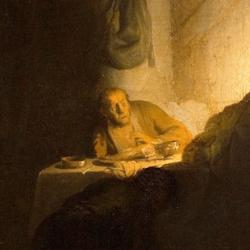Theodore Beza’s opening speech at the Colloquy of Poissy was a model of irenic Protestantism (Nugent, Ecumenism is the Age of the Reformation). He stressed the creedal commonalities of Rome and the Reformed, and argued that the differences were “matters of interpretation” and unnecessary accretions” (97). As Nugent says, his “address was conspicuously free of scurrilous attack on the Papacy, and he avoided more than an oblique reference to the labyrinthine doctrine of predestination. Presumably these questions could wait. . . . he several times allowed that the Calvinists professed belief in the Real Presence, though the statement was qualified in terms of Calvinist orthodoxy. . . . he several times confessed an openness toward any clearly warranted modification of his faith” (102).
His discussion of the real presence, though, provoked shocked gasps of “Blasphemavit,” especially is claim that Christ’s body “is as far removed from the bread and wine as is heaven from earth” (100). When the cardinal of Lorraine had a chance to respond to Beza, he focused on that issue. By Nugent’s account, he offered a view of Eucharist and real presence that rang the changes on Protestant themes:
“The fruits of the sacrament were considered fourfold: the union and reconciliation that we ought to have with each other; the union obtained with Christ; the remission of sins; and the prize of eternal life.
“He proceeded to argue for a literal exegesis of the words of institution: ‘This is my body.’ The case was supported with biblical texts and references to the early councils and to a long list of the Fathers. In case of doubt, he pleaded, who should judge the difference but the Church? His approach emphasized mystery: here ‘faith is necessary, reason superfluous.’ And the stress was upon the action of the Holy Spirit rather than the celebrant: ‘the ineffable operation of the grace of God, and power of his Holy Spirit, to be present in these holy mysteries.’ He specifically excluded Aristotelian terminology or any philosophy of the schools, though he observed that the Fathers did not shrink from adverbs like substantialiter, naturaliter, and corporaliter. He did not require a local or circumscriptive presence and, leaning as far as he could, professed that the union with Christ is not itself ‘corporeal,’ but rather ‘supernatural, supersubstantial, spiritual, invisible, ineffable, special, and proper to the sacrament.’ ‘Take it on God’s word,’ he beseeched the [Reformed] ministers, ‘for His word is infallible’” (111).
It is not known whether he thumped his Bible at this point, but he might have.
As Nugent suggests, “It had biblical appeal, so that it met the Protestants on their own ground. And if the Reformed were treated cavalierly, so were the Scholastics. It was un-Scholastic and lacking in categorical definitions. Charged terms like the Mass, transubstantiation, and the ex opere operato formula were eschewed. The Papacy was merely touched on, and infallibility applied only to Holy Writ” (114).
Lorraine view was almost as Lutheran as it was Catholic, which may have been part of an elaborate rhetorical strategy to expose and widen divisions within the Protestant movement. Considered in itself, though, there is much to comment in his argument, and it certainly seemed to offer an opening for further debate. Peter Martyr Vermigli, who was present at the Colloquy, spotted an opportunity. He found Lorraine’s speech “eloquent enough” and (in Nugent’s summary) “while he could not approve Lorraine’s exposition of the Eucharist, he suggested that in future conferences the cardinal might be found more tractable. Martyr also intimated that, pending some later settlement, the article on the Eucharist might simply be left to conscience so long as the churches preached what seemed conformable to the Word of God and lived together in fraternity” (122).













